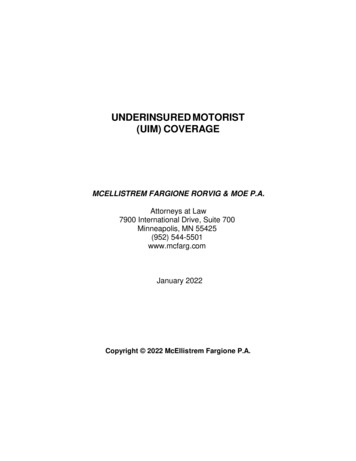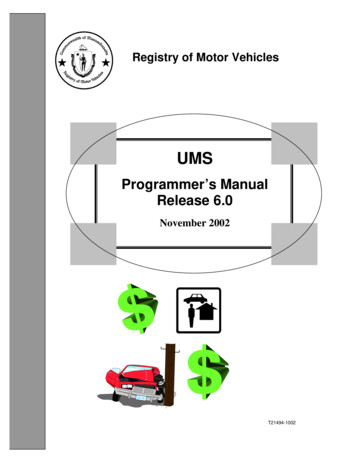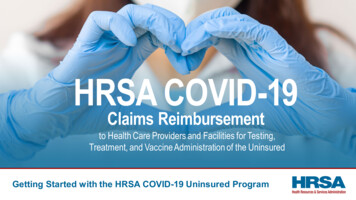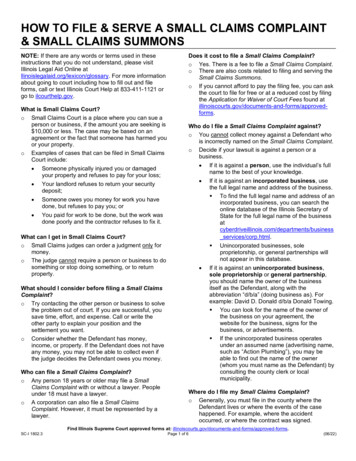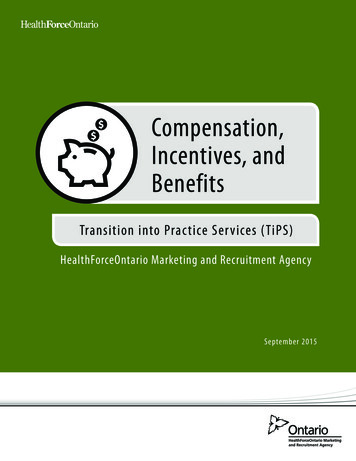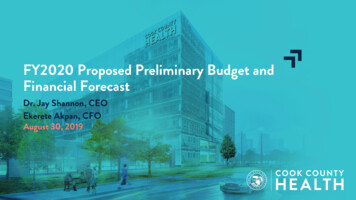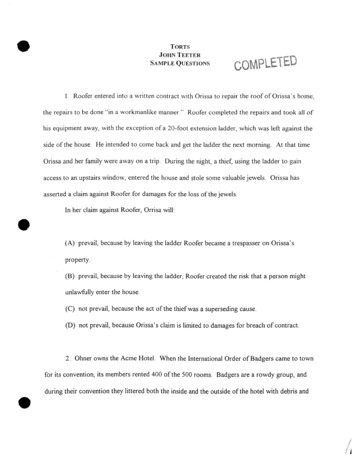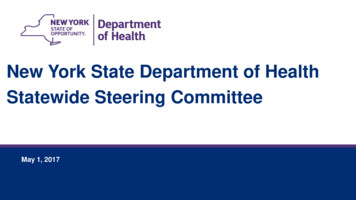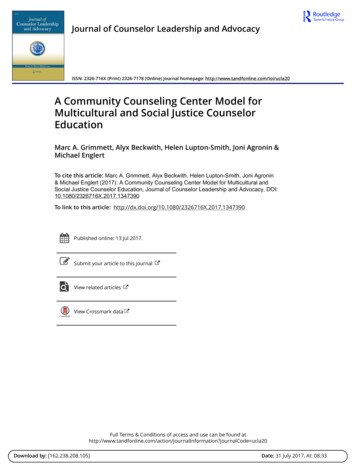
Transcription
Presenting a live 90-minute webinar with interactive Q&AUninsured and Underinsured Motorist Claims:Evaluating Triggers, Stacking, Subrogation,Substitution of BenefitsTUESDAY, JUNE 1, 20211pm Eastern 12pm Central 11am Mountain 10am PacificToday’s faculty features:Thomas A. Herald, Attorney, Thomas A. Herald, P.C., Carrollton, TXKevin J. Riexinger, Counsel, Gfeller Laurie, Princeton, NJThe audio portion of the conference may be accessed via the telephone or by using your computer'sspeakers. Please refer to the instructions emailed to registrants for additional information. If youhave any questions, please contact Customer Service at 1-800-926-7926 ext. 1.
Tips for Optimal QualityFOR LIVE EVENT ONLYSound QualityIf you are listening via your computer speakers, please note that the qualityof your sound will vary depending on the speed and quality of your internetconnection.If the sound quality is not satisfactory, you may listen via the phone: dial1-877-447-0294 and enter your Conference ID and PIN when prompted.Otherwise, please send us a chat or e-mail sound@straffordpub.comimmediately so we can address the problem.If you dialed in and have any difficulties during the call, press *0 for assistance.Viewing QualityTo maximize your screen, press the ‘Full Screen’ symbol located on the bottomright of the slides. To exit full screen, press the Esc button.
Continuing Education CreditsFOR LIVE EVENT ONLYIn order for us to process your continuing education credit, you must confirm yourparticipation in this webinar by completing and submitting the AttendanceAffirmation/Evaluation after the webinar.A link to the Attendance Affirmation/Evaluation will be in the thank you emailthat you will receive immediately following the program.For additional information about continuing education, call us at 1-800-926-7926ext. 2.
Program MaterialsFOR LIVE EVENT ONLYIf you have not printed the conference materials for this program, pleasecomplete the following steps: Click on the link to the PDF of the slides for today’s program, which is locatedto the right of the slides, just above the Q&A box. The PDF will open a separate tab/window. Print the slides by clicking on theprinter icon.
Uninsured andUnderinsured MotoristClaimsEvaluating Triggers, Stacking, Subrogation, Substitution ofBenefits.
Governing law Highly state specific – usually governed by statute There are both bodily injury and property damage coverage; thisdiscussion focuses on bodily injury State-by-state reference chart – NJ does require UM orist-coverage/9647
Nature and scope of coverageA. Purpose:Underinsured motorist coverage is meant to serve a limited purpose; itis not intended to provide coverage to compensate injured parties forthe full value of the injuries caused by the tortfeasors, but is intendedto put them in as good a position as if the tortfeasor possessed anamount of liability insurance equal to the UIM coverage under thepolicy in question. Selective Ins. Co. of Am. v. Thomas, 179 N.J. 616(2004).
Nature and scope of coverageB. Who is Covered?Generally, UM and UIM insurance coverages will include: The named insured(s); Resident relatives/spouses; Permissive users; Passengers
Nature and scope of coverageB. Who is Covered?Policies formerly sought to exclude coverage for family members.Those exclusions have been invalidated in most states.“Family member exclusion” may be valid if the family member has theirown separate policy.In those cases – courts have considered the exclusion to be in theinterests of both public policy and the insurer.
Nature and scope of coverageC. What is Covered? Most states have language in the policy
Nature and scope of coverageC. What is Covered? Up to the limit of coverage Generally any damage the insured could recover atcommon law against the tortfeasor This does not usually include punitive damages
Nature and scope of coverageC. When Does the UIM Coverage Kick In States vary on whether the UIM coverage is on: Excess Basis (after the tortfeasor’s policy limits) Reduction Basis (UIM coverage is reduced by the amount ofthe tortfeasor’s policy limits. If the UIM coverage does notexceed the tortfeasor’s policy limits, then there is no UIMcoverage Add-On Step Down
Nature and scope of coverageC. “Step Down” Endorsements Policy provisions that allow the insurer to reduce the amount ofcoverage to the minimum levels allowed by the individual state whensomeone not specifically listed on the policy is driving an insuredvehicle. Banned in some states
Nature and scope of coverageC. “Step Down” EndorsementsSignificant case pending in New Jersey involving the applicability of step-downclauses for UIM coverage: While unloading groceries from his mother’s car, plaintiff was struck by a drunkdriver and lost his leg. Tortfeasor carried state min. 15,000 in liability coverage.
Nature and scope of coverageC. “Step Down” Endorsements Plaintiff exhausted tortfeasor’s policy – sought UIM benefits from mother’s policy Plaintiff’s mother elected “ 500,000 in UM/UIM coverage” when purchasing thepolicy covering the vehicle Mother’s policy included the following step-down clause:“For any other insured person, the limits of liability for this coverage will be the mandatoryminimum limits for this coverage specified by the laws of New Jersey.”
Nature and scope of coverageC. “Step Down” Endorsements Mother’s insurance policy incorrectly lumps both UM and UIM coverages under one broadheading: “Underinsured Motorist Coverage.” UM and UIM insurance are separate and distinct coverages. Critical because NJ has a statute mandating a minimum of 15,000 in UM coverage. N.J. Stat.Ann. § 17:28-1.1, see also, N.J. Stat. Ann. § 39:6A-14. The statute is silent on UIM. See, Aubrey v. Harleysville Ins. Companies, 140 N.J. 397, 404,(1995) (holding that under N.J.S.A. 17:28–1–1b, UIM coverage is discretionary, not mandatory).
Nature and scope of coverageC. “Step Down” Endorsements Insurer took the position that this step-down provision reduces the amount ofavailable coverage to the “state minimum” of 15,000. In reality, there is no state minimum for UIM coverage. At a deposition - insurer rep admitted UM and UIM are two different coverages,and acknowledged that there is no statute in New Jersey that provides amandatory minimum amount of UIM coverage. 475,000 available in UIM if court sides with the insured plaintiff – Arguably 0 ifsides with insurer
Nature and scope of coverageC. “Step Down” EndorsementsQuestion: If insurer’s position is to be believed, have they thencharged the insured for UIM coverage that can never be triggeredunder any circumstance? (next slide covers triggers) NJ Min Required liability policy is 15,000 / 30,000 Insurer claims min required UIM is 15,000 / 30,000How can that ever trigger if UIM coverage is never greater than anycovered vehicle?
Prerequisites for paymentA. Most Basic Coverage Triggers (underinsured)1. Limits Trigger: The UIM limits in the insured’s policy must begreater than the tortfeasor’s bodily injury liability limits.2. Damages Trigger: Insured’s damages exceed the at-faultdriver’s bodily injury liability limit.
Prerequisites for paymentB. PaymentAs always – incredibly state specific (check your statutes); but generally,the following are expected: Exhaustion of tortfeasor’s policy Insured gives a statement or EUO Insurer is notified and consents to settlement
Prerequisites for paymentB. PaymentExhaustion:Exhausting a tortfeasor’s policy limits is necessary because, in theory, if a claimantsettles their claim against the tortfeasor for less than the tortfeasor’s policy limits,then the tortfeasor was adequately insured.Some States Do Not Require ExhaustionThe insured is entitled to settle with the tortfeasor for less than policy limits and stillmake a valid UIM claim. However, the UIM carrier is entitled to a credit for thefull amount of the liability limits of the tortfeasor. Leal v. Northwestern Nat’lCounty Mut. Ins. Co., 846 SW2d 576 (Tex.App.– Austin 1993, no writ); andOlivas v. State Farm Automobile Ins. Co., 850 SW2d 564 (Tex.App.–El Paso1993, writ denied).
Prerequisites for paymentB. PaymentExhaustion:Even exhaustion is treated differently depending on your venue.New Jersey, courts have permitted claims for UIM benefits even in circumstances where claimants failedto settle with the tortfeasor for their entire policy limits. Insurer was still entitled to a credit of the fullamount of tortfeasor’s limits, however. See, Hreshko v. Harleysville Ins. Co., 337 N.J. Super. 104 (App.Div. 2001); see also, Tlumacki v. CNA Ins. Companies, No. A-4024-05T5, 2009 WL 816262 (N.J. Super.Ct. App. Div. Mar. 31, 2009)The Supreme Court of Idaho has held that the exhaustion clause of an insured’s policy was void, againstthe state’s declared public policy aimed at protecting its citizens from underinsured drivers, andcontravened the doctrine of judicial economy. Hill v. American Family Mut. Ins. Co., 150 Idaho 619 (2011).
Prerequisites for paymentB. PaymentExamination Under Oath: Most policies call for an insured to provide an EUO before perfecting a UMor UIM claim. A Maryland court held that an EUO was a mandatory “condition precedent”to coverage. Dolan v. Kemper Indep. Ins. Co., 237 Md. App. 610 (2018). Infact, even if a appears for an EUO, they commit a material breach of theirinsurance contract if they fail to answer relevant and material questions. Id. Numerous state courts have held that the unexcused failure to appear at anEUO permits an insurer to disclaim coverage In other states, failure to give an EUO will entitle the insurer to abate thelawsuit, but failure to timely assert such a right may result in waiver of theright to get the EUO.
Prerequisites for paymentB. PaymentConsent-to-Settle Clauses: Certain policies include a “consent-to-settle” clause requiring the insured to providenotice to and obtain consent from their UIM carrier prior to the settling any claimsagainst the (apparently) underinsured tortfeasor and/or releasing the tortfeasor from allfuture liability. The Supreme Court of Alabama pointed out that, “Courts in a number of states haverecognized that the purpose of consent-to-settle clauses in the [UM/UIM] motoristinsurance context is to protect the [UIM] carrier’s subrogation rights against the tortfeasor, as well as to protect the carrier against the possibility of collusion between theinsured and the tort-feasor at the carrier’s expense.” Lambert v. State Farm Mut. Auto.Ins. Co., 576 So. 2d 160, 164 (Ala. 1991).
Amount of Coverage and StackingA. Calculating Coverage (generally) UM Coverage is easy – consult limits in policy if tortfeasor wasuninsured UIM Coverage is a bit more nuanced
Amount of Coverage and StackingA. Calculating Coverage (generally)UIM Coverage First check triggers – Limits Trigger Damages Trigger Scenario: Auto A is struck by Auto B. Driver of Auto A is injured.Auto B is insured with bodily injury liability limits of 20,000 perperson. Driver of Auto A maintains an insurance policy with 100,000of UIM coverage. In this case, Driver of Auto A will be eligible tocollect 80,000 in benefits (his own UIM limits reduced by thetortfeasor’s bodily injury limits). Does not mean Driver A collects 80,000 – that is what is available tothem.
Amount of Coverage and StackingA. Calculating Coverage (generally)UIM Coverage Scenario (continued): If Driver of Auto A settles with Driver of Auto B for 19,000,then no UIM claim is triggered (usually). In that scenario, Auto B was adequately insured to cover the loss. If Auto B tenders policy limits to Driver of Auto A, UIM claim is in play. The inquiry turns to whether Auto B policy limits fully and fairly compensatedDriver of Auto A. If Driver of Auto A sustained catastrophic injuries regularly compensated in excessof his 100,000 in UIM coverage—then insurer of Auto A will (or should) pay itsinsured the available 80,000 of UIM benefits. If the injuries sustained are less serious, the insurer of Auto A seeks to settle withits insured for a fair amount within the UIM policy limits that would make Driver ofAuto A whole.
Amount of Coverage and StackingB. StackingSome states allow coverage “stacking.” Stacking is the application oftwo or more policies’ limits to a single occurrence, claim, or loss.Whether your state allows stacking is generally dependent on yourparticular state UM and UIM statutes. For instance, New Jersey has astrict Anti-Stacking Statute (N.J. Stat. § 17:28-1.1(c)).
Amount of Coverage and StackingB. StackingStacking usually works in one of two general ways:1) Intra-policy stacking: combining more than one coverage limit withina single policy and applying the aggregate of those limits to anindividual loss; or 1) Inter-policy stacking:combining coverage under more than onepolicy and applying the aggregate limits to an individual loss.
A.STACKING POLICIES: GENERAL RULE:1)Usually permitted if the stacking occurs between twodifferent policies:Separate UM policies:PERMITTEDSeparate UIM policies: PERMITTEDUsually prohibited if stacking is within the samepolicy.Usually prohibited to stack the LIABILITY and UMor UIM coverage under the same policy: Hanson v.Republic Ins. Co., 5 S.W.3d 324 (Tex. App. - Houston[1st Dist.] 1999, pet. denied), and Jankowiak v.Allstate, 201 S.W.3d 200 Tex. App. - Houston [14thDist] 2006, no pet.).a.b.c.d.
Amount of Coverage and StackingB. Stacking Example 1: an insured carries a policy with a UM limit of 20,000covering three different vehicles. One of those vehicles is in an accidentwith an uninsured driver. Intra-policy stacking would allow the insuredto recover up to 60,000. Example 2: an insured student living at home owns his own insuredvehicle. The student gets into an accident with an uninsured driverwhile driving his parents’ vehicle. Inter-policy stacking would allow thestudent to stack coverages under his policy and his parents’ policy(ies).
Amount of Coverage and StackingB. StackingThe Insurance Follows The CarCases where more than one policy provides coverage for the same loss (Interpolicy stacking) often requires a determination as to which policy is primary (paysfirst). Scenario: Driver borrows Owner’s car. Driver has his own personal autoinsurance covering him when he is a permissive driver of another vehicle not on hispolicy. Owner also has insurance on the car he is lending to Driver. In the case ofan accident, the rule of thumb is that insurance on the car is primary (driver’spersonal insurance is excess). Ohio Farmers Ins. Co. v. Ohio Cas. Ins. Co., 28Ohio App. 2d 170, 174 (Ohio Ct. App. 1971). That rule has been long recognizedby most insurance companies. Id. “To use a shorter term-insurance follows thecar.” Id.
Amount of Coverage and StackingB. StackingAllstate Ins. Co. v. Hague, 449 U.S. 302 (1981) SCOTUS decided Hague in 1981. More of a “choice of law matter” but highlights different state lawsleading to different outcomes re: UM/UIM Man dies in an accident in Wisconsin while riding as a passenger on a motorcycle. Neither vehicle operator was insured. Deceased maintained a policy that covering three vehicles with 15,000of UM coverage each. Minnesota allows stacking – Wisconsin does not Widow sued in Minnesota seeking to “stack” UM coverages. Insurer sought to have the court apply Wisconsin law arguing parties involved were Wisc. residents, policywas issued in Wisc., and accident happened in Wisc. Minnesota Supreme Court applied Minnesota law and ruled in favor of the widow.
Amount of Coverage and StackingB. StackingSCOTUS affirmed: Neither the due process clause nor full faith and credit clause were violated by applying Minnesota law toallow “stacking.” Even with Wisconsin policy, residents, and accident - Deceased worked in and commuted to Minnesota for 16years prior to death. Place of an accident is merely one fact to be considered in choice–of–law analysis Deceased’s employment status was not a sufficiently less important status than his residence status whencombined with his daily commute Insurer was present and doing business in Minnesota at all relevant times and deceased’s widow became aMinnesota resident (for other reasons) prior to brining suit. “An automobile accident need not occur within a particular jurisdiction for that jurisdiction to be connected tothe occurrence.” Hague, at 314. SCOTUS was clearly unimpressed with the Minnesota Supreme Court’s decision to apply its own law; butfound no basis to invalidate the decision.
Amount of Coverage and StackingB. StackingPennington v. State Farm Mut. Auto. Ins. Co, 553 F.3d 447 (6th Cir. 2009)Under Kentucky law, the personal nature of UIM coverage creates areasonable expectation that payment of separate premiums results inseparate coverages, and if insured has paid additional money withoutreceiving additional coverage, stacking is necessary to preventinsurance companies from depriving insured of benefits that they havealready paid for. Pennington, at 451.
Amount of Coverage and StackingB. StackingPallay v. Nationwide Ins. Co., 165 Ohio App. 3d 242 (2005)Passenger in a car being driven by his wife was injured in an accident.Injured party attempted to collect under both the liability and UIMcoverages that insured the vehicle. Pallay court held that an insurercould enforce its intra-policy anti-stacking clause so as to bar insuredfrom recovering UIM benefits after receiving 100,000 benefit limitfrom liability coverage under same auto policy.
Amount of Coverage and StackingB. StackingJankowiak v. Allstate, 201 S.W.3d 200 Tex. App. - Houston [14th Dist]2006, no pet.)The Court held that the claimant could recover policy both: LIABILITY COVERAGE against the driver of the vehicle the insured occupiedfor his driver’s negligence, and UNINSURED MOTORIST COVERAGE benefits under the same policy for thenegligence of the uninsured driver that was also negligent and proximately causedthe occurrence.
Amount of Coverage and StackingB. StackingStacking in Pennsylvania Pennsylvania’s Motor Vehicle Financial Responsibility Law or “MVFRL” mandates thatinsurers present insureds with “stacking waivers” when purchasing insurance coverage. An insured can waive the right to stack in exchange for a reduced policy premium. Absent a signed waiver, the insured may stack UM or UIM claims based on the sum ofthe limits of coverage on vehicles on all applicable policies. The statute addresses both inter-policy stacking and intra-policy stacking—either can bewaived by a signed form. See, Generette v. Donegal, 884 A.2d 266 (Pa. Super. 2005).
Amount of Coverage and StackingB. StackingStacking in PennsylvaniaWhat happens when an insured makes changes to their policy? Must they execute anotherwaiver? In 2019 the Pennsylvania Supreme Court said, yes. Subsection (c) of the MVFRLstates:(c) More than one vehicle. Each named insured purchasing uninsured or underinsuredmotorist coverage for more than one vehicle under a policy shall be provided the opportunityto waive the stacked limits of coverage and instead purchase coverage as described insubsection (b). The premiums for an insured who exercises such waiver shall be reduced toreflect the different cost of such coverage. 75 Pa. Stat. and Cons. Stat. Ann. § 1738 (c);(emphasis added).
Amount of Coverage and StackingB. StackingStacking in PennsylvaniaBarnard v. Travelers Home & Marine Ins. Co., 216 A.3d 1045 (Pa. 2019). Plaintiff sought to increase her UIM coverage on a policy she previouslymaintained. Insurer never asked her to sign another stacking waiver though plaintiffhad executed a waiver when originally purchasing the policy. The Supreme Court of Pennsylvania nevertheless held that this increaseto the limits of UIM coverage for multiple vehicles under an existing autopolicy constitutes a “purchase” within the meaning of MVFRL.
Amount of Coverage and StackingB. StackingStacking in PennsylvaniaBarnard v. Travelers Home & Marine Ins. Co., 216 A.3d 1045 (Pa. 2019).The court concluded that increasing one’s coverage limits qualifies as a “purchase” andtriggers an obligation by an insurance company to offer its insured another stacking waiver.The court stated, “[w]e conclude that an insurance company must offer an insured theopportunity to waive stacking any time she acquires UIM coverage for more than onevehicle, regardless of whether this acquisition occurs when she initially applies for aninsurance policy or when she subsequently increases her UIM coverage limits formultiple vehicles.” Barnard, at 1054.
Bad Faith Issues
Bad Faith IssuesWhat is “Bad Faith”?The legal definition of “Bad Faith” varies greatly from state to state. Some states: “Bad Faith” is defined solely by statute; Some states: “Bad Faith” may also have common law definitions of what is or is not “badfaith” In some states: there is no “Bad Faith” claim applicable to UM/UIM cases. Virginia has no right to bring a bad faith claim arising out of the handling UM/UIMclaims. Manu v. Geico Cas. Co., 293 Va. 371 (2017). The insurer has no legalobligation to pay the claim until the insured proves the insured is “legally entitled torecover” damages. In some states there is even bad faith in failure-to-settle third party liability claims. New Mexico
Bad Faith IssuesWhat is “Bad Faith”?The legal definition of “Bad Faith” varies greatly from state to state. Arkansas: “bad faith” is defined as dishonest, malicious, or oppressive conduct carried out with a state ofmind characterized by hatred, ill will, or a spirit of revenge. Mere negligence or bad judgment is insufficient so long as the insurer is acting in good faith. The tort of bad faith does not arise from a mere denial of a claim; there must be affirmativemisconduct. Honest errors of judgment and bad judgment are insufficient; Value disputes are not bad faithState Auto Prop. & Cas. Ins. Co. v. Swaim, 338 Ark. 49, 56, 991 S.W.2d 555, 559 (1999); See Stevensonv. Union Std. Ins. Co., 294 Ark. 651, 746 S.W.2d 39 (1988). Alaska: The insurer must act fairly and in good faith in discharging its contractual responsibilities. Bad faithinsured refusing, without proper cause, to compensate its insured for loss covered by the policy. State FarmFire & Cas. Co. v. Nicholson, 777 P.2d 1152 (1989) Arizona: An insurer may be found liable for bad faith even if no coverage exists for the claim if the insurer’sconduct was unreasonable and unduly harmed an insured or a third party. Deese v. State Farm Mut. Auto.Ins. Co., 838 P.2n 1265 (Az. 1992)
Bad Faith IssuesWhat is “Bad Faith”?The legal definition of “Bad Faith” varies greatly from state to state. California: To prevail on a bad faith claim, the insured must show (1) the insurer withheld benefits due under the policy;and (2) such withholding was unreasonable or without proper cause. The actionable withholding of benefits may consistof the denial of benefits due, paying less than due, and/or unreasonably delaying payment due. Major v. Western HomeIns. Co, 87 Cal. Rptr. 3d 556 (4th Dist, Div. 1, 2009) Georgia: To prevail on a claim of bad faith, the insured must show: (1) that the claim is covered under the policy; (2) that ademand for payment was made against the insurer within 60 days prior to filing suit; (3) that the insurer’s failure to paywas motivated by bad faith. Ga Code Ann. Section 33-4-6.
Bad Faith IssuesWhat is “Bad Faith”?The legal definition of “Bad Faith” varies greatly from state to state. Hawaii: Bad faith is the failure to deal fairly and in good faith with its insured by refusing, without proper cause, tocompensate its insured for a loss covered by the policy. Best Place, Inc. v. Penn America Ins. Co. 920 P.2d 334 (1996). Theinsured was permitted to bring a bad faith claim even though there was clearly no coverage under the policy bymishandling the claim. Enoka v. AIG Hawaii Ins. Co., Inc. 128 P.3d 850 (Ha 2006) The insured need not prove he sufferedeconomic or physical loss caused by the bad faith in order to recover emotional distress damages. Miller v. Hartford LifeIns. Co. 268 P.3d 418 (Ha 2011) Idaho: To recover on a bad faith claim, the insured must show (1) the insurer intentionally and unreasonably denied orwithheld payment; (2) the claim was not fairly debatable; (3) the denial or failure to pay was not the result of a good faithmistake; and (4) the resulting harm is not fully compensable by contract damages. Harmon v. State Farm Mut. Auto.Ins. Co., 394 P.3d 796, (2017) Illinois:Bad faith is a purely statutory claim. The insured must show the insurer’s conduct was “vexatious andunreasonable.” Section 155 of the Illinois Insurance Code (215 ILCS 5/155)
Bad Faith IssuesWhat is “Bad Faith”?The legal definition of “Bad Faith” varies greatly from state to state. Indiana: Bad faith is (1) making an unfounded refusal to pay policy proceeds; (2) causing an unfounded delay in makingpayment; (3) deceiving the insured; and (4) exercising any unfair advantage to pressure an insured into a settlement of theclaim. Auto-Owners Ins. Co. v . C&J Real Estate, Inc. 996 N.E. 2d 808 (In. 2013) Nebraska: Where the facts supporting bad faith differ from those supporting the breach of contract claim, an insuredneed not prevail on the breach of contract claim as a condition precedent to prevail on a bad faith claim. Further, theultimate payment of the claim does not defeat a bad faith claim. LeRette v. American Medical Security, Inc., 705 N.W.2d41 (Neb. 2005) New Mexico: The insured must show that the insurers reasons for denying payment of the claim were frivolous andunfounded or (2) in failure-to-settle cases, the liability insurer’s failure or refusal to settle the claim against the insuredwas based on a dishonest or unfair balancing of interests. Sloan v. State Farm Mut. Auo Ins. Co. 135 N.M.2018)
Bad Faith IssuesWhat is “Bad Faith”?The legal definition of “Bad Faith” varies greatly from state to state. Nebraska: Where the facts supporting bad faith differ from those supporting the breach of contract claim, an insuredneed not prevail on the breach of contract claim as a condition precedent to prevail on a bad faith claim. Further, theultimate payment of the claim does not defeat a bad faith claim. LeRette v. American Medical Security, Inc., 705 N.W.2d41 (Neb. 2005) New Mexico: The insured must show that the insurers reasons for denying payment of the claim were frivolous andunfounded or (2) in failure-to-settle cases, the liability insurer’s failure or refusal to settle the claim against the insuredwas based on a dishonest or unfair balancing of interests. Sloan v. State Farm Mut. Auo Ins. Co. 135 N.M.2018) Oklahoma: To make a prima facie case of bad faith, the insured must show: (1) the claim was covered under the policy;(3) the insure was required to take reasonable actions in the handling of the claim; (3) the actions of the insurers wereunreasonable under the circumstances; (4) the insurer failed to deal fairly and to act in good faith toward the insured inthe handling of the claim; and (4) the breach or violation of the duty of good faith and fair dealing was the direct cause ofdamages sustained by the insured. Badillo v. Mid Century Ins. Co., 121 P.3d 1080 (2005) Oregon: A breach of the duty of good faith may occur independently of, or even without, any brach of contract. McKenziev.P ac. Health & Life Ins. Co., 118 Or. App. 377 (1993).
Bad Faith IssuesWhat is “Bad Faith”?The legal definition of “Bad Faith” varies greatly from state to state. Nevada: Bad faith is when the insurer refuses the claim without proper cause and the claim was for a loss covered by thepolicy.” Estate of Lomastro ex re. Lomastro v. American Family Ins. Group, 195 P.3d 339, (Nev. 2008) Wyoming: “A plaintiff must establish (1) the absence of any reasonable basis for denying the claim; and (2) the insurer’sknowledge or reckless disregard of this lack of a reasonable basis for denying the claim. Gainsco Ins. Co. v. AmocoProduction Co., 53 P3d 1051 (2002)
Bad Faith IssuesWhat is “Bad Faith”?The legal definition of “Bad Faith” varies greatly from state to state. Texas: Texas has transitioned its definitions of what is “Bad Faith” over time.1)Arnold v. National County Mutual Fire Ins., 75 S.W.2d 165 (Tex. 1987).a. No reasonable basis for denial or delay of payment; orb. Failure to determine if there was a reasonable basis to deny or to delay payment of the claim.2)Aranda v. Ins. Co. Of N. America, 748 S.W.2d 210 (Tex. 1988)a. In the absence of a reasonable basis to deny or delay payment; andb. Insurance company knew or should have known there was no reasonable basis to deny or to delay paymentof the claim.3)Transportation Ins. Co. v. Moriel, 879 S.W.2d 10 (Tex. 1994).a.4)If there is a bona fide dispute, there is no bad faith.Universal Life Ins. Co. v. Giles, 950 S.W.2d 48 (Tex. 1997)a. Failing to attempt in good faith to effectuate a prompt, fair and equitable settlement of a claim when insurer’sliability become “reasonably clear”;b. Essentially this is a negligence standard where the insured must prove the insurance company knew orshould have known it needed to pay this covered claim.
Bad Faith IssuesWhat is “Bad Faith”?The legal definition of “Bad Faith” varies greatly from state to state. Texas: Texas has transitioned its definitions of what is “Bad Faith” over time.1)USAA Texas Lloyds Co. v. Menchaca, 545 S.W.3d 479 (Tex. 2018).The Supreme Court acknowledges that some of its previous decisions have created uncertainty in the law. As aresult, this opinion is designed to put that uncertainty to rest as nearly as possible.On re-hearing, the Texas Supreme Court affirmed its five rules governing the relationship between contractualand statutory claims from its or
Jun 1, 2021
